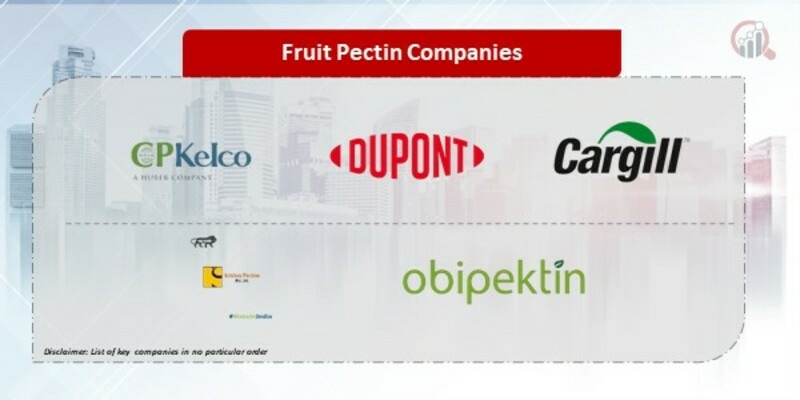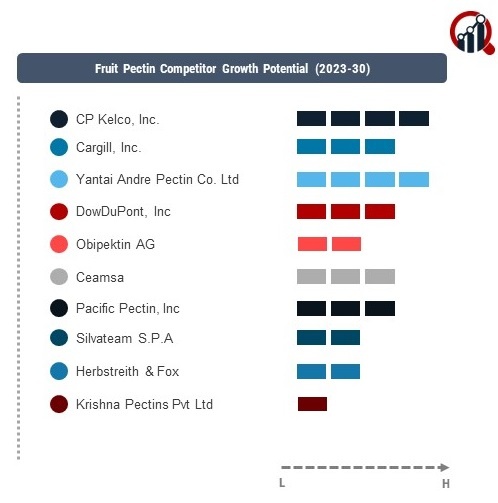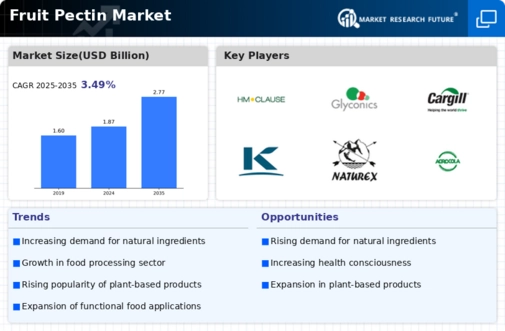Top Industry Leaders in the Fruit Pectin Market

The Competitive Landscape of the Fruit Pectin Market is characterized by key players strategically navigating the food and beverage industry to meet the growing demand for natural texturizing agents and gelling agents. As of 2023, established manufacturers, along with emerging companies, have implemented various strategies to capitalize on the increasing consumer preference for clean-label and plant-based ingredients.
Key Players:
CP Kelco U.S. Inc. (U.S.)
Yantai Andre Pectin Co. Ltd. (China)
Obipektin AG (Switzerland)
Pacific Pectin Inc. (U.S.)
Herbstreith & Fox (Germany)
Krishna Pectins Pvt Ltd (India)
Cargill Inc. (U.S.)
DowDuPont Inc. (U.S.)
Ceamsa (Spanish Company of Algas Marinas SA) (Spain)
and Silvateam S.P.A (Italy).
Strategies Adopted:
The Fruit Pectin Market revolve around product diversification, acquisitions, and sustainability initiatives. Product diversification involves expanding the range of pectin products to include low-methoxyl pectin, high-methoxyl pectin, and amidated pectin to cater to diverse industry needs. Acquisitions play a crucial role in market consolidation, enabling companies to strengthen their position and enhance their portfolio with complementary products. Sustainability initiatives, such as investing in eco-friendly sourcing practices and reducing the environmental impact of pectin production, align with the growing consumer demand for environmentally conscious products.
Market Share Analysis:
The Fruit Pectin Market is influenced by factors such as product range, quality standards, pricing, and customer relationships. Companies offering a comprehensive range of pectin products, including tailor-made solutions for specific applications, often secure larger market shares due to versatility and adaptability. Adherence to high-quality standards, including certifications for organic and non-GMO products, contributes to building consumer trust and brand loyalty. Competitive pricing strategies that balance affordability with product quality are essential for attracting a broad customer base. Robust customer relationships, often facilitated through effective supply chain management, contribute to long-term market presence and stability.
New & Emerging Companies:
New and emerging companies in the Fruit Pectin Market contribute to the competitive landscape by focusing on innovative extraction methods, sustainable sourcing, and addressing niche market segments. Start-ups such as Herbstreith & Fox KG Pektin-Fabriken and Silvateam S.p.A. have entered the market, emphasizing sustainable and traceable sourcing of fruit-based raw materials for pectin production. While these companies may have relatively smaller market shares compared to industry giants, their agility, focus on specific market niches, and commitment to sustainability add dynamism to the market.
Industry Trends:
Industry trends provide insights into ongoing developments within the Fruit Pectin Market. A notable trend in 2023 is the increased investment in research and development to discover and commercialize novel pectin formulations. Key players are actively exploring alternative sources for pectin extraction, such as apple pomace and citrus peels, to offer unique and sustainable alternatives. Investments in sustainable sourcing practices, including supporting local farmers and reducing waste in the supply chain, reflect the industry's commitment to environmental responsibility.
Competitive Scenario:
The Fruit Pectin Market remains dynamic, with companies adapting diverse strategies to stay competitive in this rapidly evolving industry. Digitalization of marketing and communication channels is becoming essential for companies to connect with consumers directly, gather feedback, and adapt to changing preferences. Collaborations with food manufacturers, particularly those involved in the production of jams, jellies, and confectionery, contribute to understanding market trends and aligning pectin offerings with evolving industry needs.
Recent Development
The Fruit Pectin Market is the increased focus on organic and clean-label pectin formulations. Key players are responding to the growing consumer demand for natural and minimally processed ingredients by offering organic pectin options. This development aligns with the broader industry trend towards clean-label and transparent ingredient lists, reflecting the industry's commitment to meeting evolving consumer expectations.










